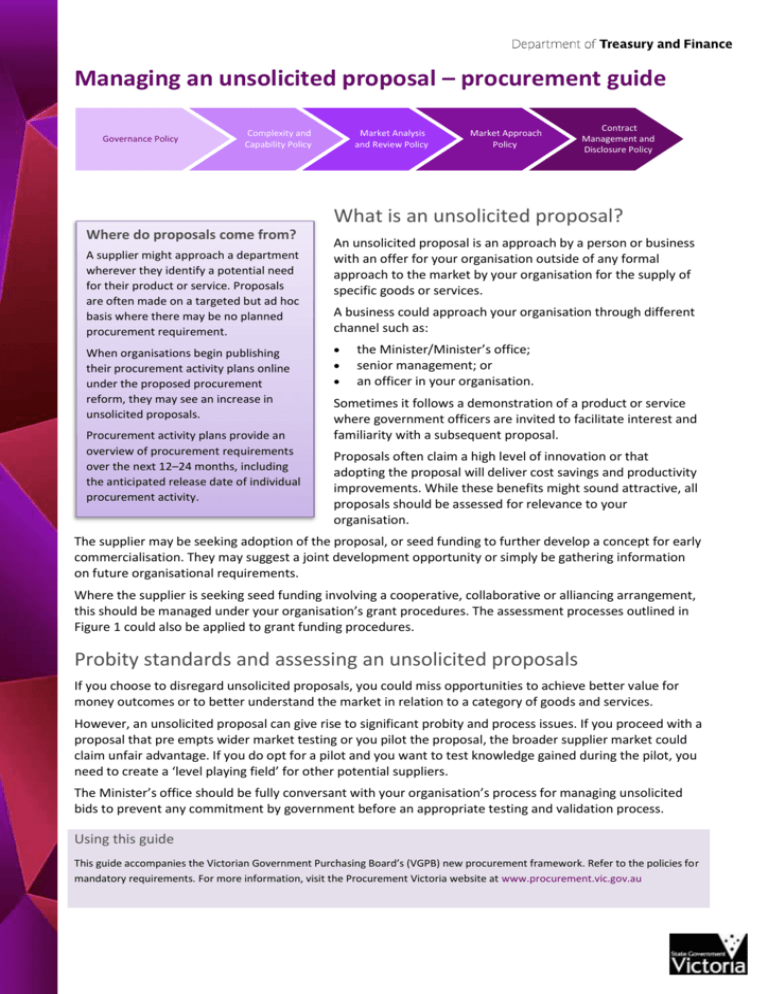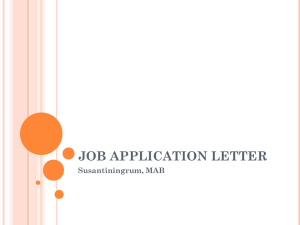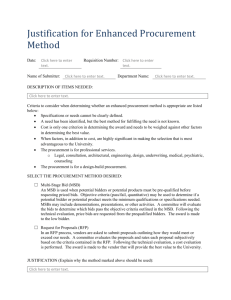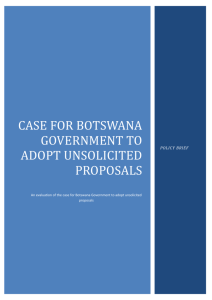Guide-to-managing-an-unsolicited-proposal
advertisement

Managing an unsolicited proposal – procurement guide Governance Policy Complexity and Capability Policy Market Analysis and Review Policy Market Approach Policy Contract Management and Disclosure Policy What is an unsolicited proposal? Where do proposals come from? A supplier might approach a department wherever they identify a potential need for their product or service. Proposals are often made on a targeted but ad hoc basis where there may be no planned procurement requirement. When organisations begin publishing their procurement activity plans online under the proposed procurement reform, they may see an increase in unsolicited proposals. Procurement activity plans provide an overview of procurement requirements over the next 12–24 months, including the anticipated release date of individual procurement activity. An unsolicited proposal is an approach by a person or business with an offer for your organisation outside of any formal approach to the market by your organisation for the supply of specific goods or services. A business could approach your organisation through different channel such as: the Minister/Minister’s office; senior management; or an officer in your organisation. Sometimes it follows a demonstration of a product or service where government officers are invited to facilitate interest and familiarity with a subsequent proposal. Proposals often claim a high level of innovation or that adopting the proposal will deliver cost savings and productivity improvements. While these benefits might sound attractive, all proposals should be assessed for relevance to your organisation. The supplier may be seeking adoption of the proposal, or seed funding to further develop a concept for early commercialisation. They may suggest a joint development opportunity or simply be gathering information on future organisational requirements. Where the supplier is seeking seed funding involving a cooperative, collaborative or alliancing arrangement, this should be managed under your organisation’s grant procedures. The assessment processes outlined in Figure 1 could also be applied to grant funding procedures. Probity standards and assessing an unsolicited proposals If you choose to disregard unsolicited proposals, you could miss opportunities to achieve better value for money outcomes or to better understand the market in relation to a category of goods and services. However, an unsolicited proposal can give rise to significant probity and process issues. If you proceed with a proposal that pre empts wider market testing or you pilot the proposal, the broader supplier market could claim unfair advantage. If you do opt for a pilot and you want to test knowledge gained during the pilot, you need to create a ‘level playing field’ for other potential suppliers. The Minister’s office should be fully conversant with your organisation’s process for managing unsolicited bids to prevent any commitment by government before an appropriate testing and validation process. Using this guide This guide accompanies the Victorian Government Purchasing Board’s (VGPB) new procurement framework. Refer to the policies for mandatory requirements. For more information, visit the Procurement Victoria website at www.procurement.vic.gov.au Figure 1 outlines a framework for managing unsolicited proposals. Figure 1: Framework for managing unsolicited proposals Unsolicited proposal received by Minister/ Minister’s Office Unsolicited proposal received by Department Unsolicited proposal Unsolicited proposal Refer to Note 1 Refer to Note 1 If relevant treat as grant High level assessment – Stage 1 (see link below for details) High level assessment – Stage 1 Nature of proposal – goods/services – systems related – service related – progress related – programs related Proposed arrangement Seed funding sought (refer grants processes) – share ownership – alliancing – collaboration – seek adoption/purchase Proposal relevance to: – Department priorities – Department programs – Department projects – Department activities – WoVG objectives* – Other stakeholders Indicative degree of innovation – market scan – no known suppliers/limited supplier base – evidenced innovation in other relevant settings/usage * If the proposal has a WoVG relevance, the matter should be brought to the attention of Strategic Sourcing. Sufficient relevance to proceed as a discreet procurement activity No relevance or insufficient grounds for a discrete procurement activity Assessment of relevance – Stage 2 (see link below for details) Inform proponent grounds for not proceeding as a discreet procurement activity or proceeding with the proposal as part of a normal process If relevant development business case and path to market strategy Refer to market analysis Refer to Note 2 Conduct sourcing, evaluation, negotiation, selection engagement, contract management Assessment of relevance – Stage 2 – Program relevance – project relevance – priorities relevance – WoVG relevance – organisation impact – resource impact – analysis of claimed innovation – change management impact – market analysis – secondary supply analysis – cost benefit analysis – total cost of ownership – risk assessment – value for money assessment Note 1 Develop procedures for receiving, assessing and managing unsolicited proposals. Note: Ensure the Minister/Minister’s office is informed about the organisation’s procedures for dealing with unsolicited bids and does not commit to proposals prior to assessment by departments. Note: Where the supplier is seeking funding to develop the proposal, the matter should be progressed under the department’s grants application and funding arrangements. Managing an unsolicited proposal – procurement guide 2 For all other proposals: disclose internal processes on the department’s intranet; implement a registration system to track proposals received; adopt a methodology for allocating responsibility for assessing and managing proposals; and indicate whether the complexity of certain proposals require escalation to the chief procurement officer for specific business unit input. Proceed on the basis that the supplier is fully informed of the management process with particular reference to : the proponent is to provide sufficient documentation against each of the areas of assessment noted in stage 1 of figure 1. non commitment for funding/purchase/adoption, etc.; management of organisation/supplier intellectual property (IP); confidentiality obligations; contact/communication arrangements during assessment phase; whether external parties may be engaged to assist assessment; potential timelines/milestones; and debrief opportunities for suppliers if not proceeding with proposal. Note 2 Conducting a pilot appraisal and then proceeding to the wider market raises significant probity issues especially in relation to managing and disclosing IP. Standards of equity and fairness require all potential suppliers to have equal access to generated IP and any background information previously made available to the supplier of the unsolicited proposal. Standard procurement processes apply when approaching the market with a quotation or any form of tender. Managing an unsolicited proposal – procurement guide 3








